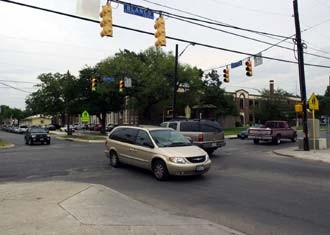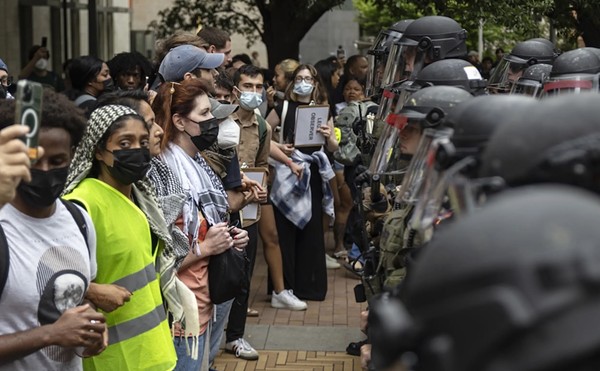|
Beacon Hill divided over circle on Blanco At a one-on-one "press conference" last Thursday afternoon, Beacon Hill neighborhood activist Martin Leyvani discussed the brewing controversy over a proposed traffic roundabout at the Fulton and Blanco intersection: "It's really a no-brainer. The data and consensus was formulated by 142 volunteers so it's already been decided." If built, the roundabout would be part of overall street improvements approved and funded for the Midtown on Blanco district, which runs from Hildebrand to Summit. Opposition to the roundabout has coalesced around Agnes Cotton Elementary, whose newly renovated and expanded buildings sit on the southeast corner of the busy intersection. At a neighborhood meeting hosted by District 1 Councilman Roger Flores last week, mothers and crossing guards expressed fear that schoolchildren crossing Blanco will not be able to navigate the traffic. Residents and business owners who spoke in favor of the plan cited data showing that roundabouts are much safer than traditional stoplight intersections, and said they hoped that the design would provide a focal point for the neighborhood's slow revitalization. Like many once-prosperous commercial corridors in the inner city, Midtown's properties show a mix of peeling paint, weeds, manicured landscaping, and glittering new windows. One of the well maintained businesses is Profiles Hair & Nail Salon, owned by Leyvani, who grew up in Beacon Hill and attended Cotton Elementary where his mother served as PTA president. He spearheaded the neighborhood improvement plan that he says has the support of the majority of residents and merchants. "`Opponents` are manipulating the new mothers at Cotton," he said. Blanca Duran, a former PTA treasurer whose son attended Cotton, sums up the mothers' fears. "We're not familiar with roundabouts. I think people are going to have a difficult time dealing with them." That's the single most common objective to roundabouts, says engineer Michael Wallwork, who has designed them in five countries, including the U.S. "People really don't understand that roundabouts slow traffic down ... you can't drive much over 18mph." Independent studies show a significant improvement in safety for drivers, pedestrians, and bikers at properly designed roundabouts, in part because the number of points at which a pedestrian must cross traffic patterns is reduced from 24 to eight and because the roundabout focuses drivers' eyes at street level rather than up at a traffic signal. The City has compiled a list of 47 roundabouts located adjacent to or near schools in a variety of towns and cities. The key, says Wallwork, is the diameter of the center: If it's small enough you can keep the speed at a maximum of 22 to 23mph. "At 20mph you `can` stop on a dime." Attorney Curt Cukjati, whose law firm is close to completing a $900,000 renovation of the 1920s Modern Locker Plant building at 1802 Blanco, doesn't understand the opposition. "Everything I've read suggests they're going to be much safer," he said, noting that it will also benefit the avenue's merchants to have traffic rolling through at a slower speed. That doesn't assuage Duran's concerns: "It's just a handful of businesses wanting to slow traffic down so they'll notice the business." Duran said that, so far, the City has not produced data from a roundabout near a school that matches exactly the scenario at Cotton. Besides, she said, there's nothing wrong with the current intersection. "It's always worked fine. I've lived here 21 years." Leyvani, the father of two children, worries that fear of change and gentrification lies at the heart of the opposition, exacerbated by the fact that over the course of a decade of planning, councilmembers and other key participants have changed. "I wish that Councilman Flores had exhibited some leadership and told these ladies that their fears had already been taken into consideration by former PTA members, and the former `Cotton` principal, Mrs. Bagwell, had a hand in the decision." • By Elaine Wolff
|
Tags:

KEEP SA CURRENT!
Since 1986, the SA Current has served as the free, independent voice of San Antonio, and we want to keep it that way.
Becoming an SA Current Supporter for as little as $5 a month allows us to continue offering readers access to our coverage of local news, food, nightlife, events, and culture with no paywalls.
Scroll to read more San Antonio News articles
Newsletters
Join SA Current Newsletters
Subscribe now to get the latest news delivered right to your inbox.


















